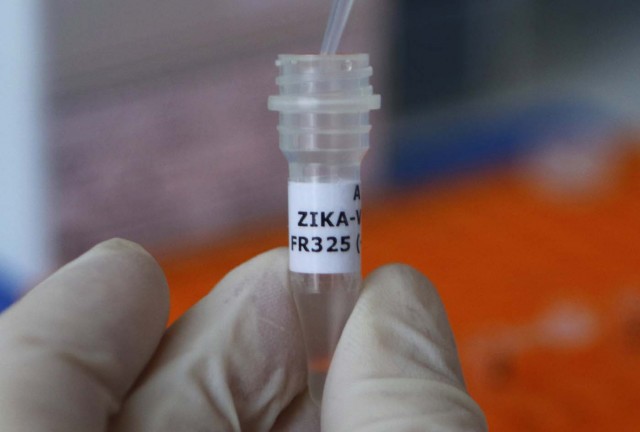Hombres con zika deberían esperar seis meses para tener sexo sin protección
on marzo 26, 2016 2:00 pm .
Publicado en La Patilla: Actualidad, Salud

REUTERS/Ina Fassbender
Los hombres diagnosticados con el virus de Zika o tuvieron síntomas de la enfermedad deberían esperar al menos seis meses antes de tener relaciones sexuales sin protección, informaron el viernes autoridades sanitarias estadounidenses.
AFP
Mientras, las mujeres en igual condiciones deberán esperar al menos ocho semanas después de la aparición de los síntomas de la enfermedad para intentar embarazarse, dijo el Centro de Control y Prevención de enfermedades (CDC, en inglés) en una actualización de sus recomendaciones.
Los periodos de espera aconsejados son los mismos para las parejas sexualmente activas que no buscan procrear.
El virus de Zika ha sido vinculado a casos de microcefalia en bebés nacidos de madres infectadas durante el embarazo. Este fenómeno evita que el cerebro del feto se desarrolle completamente.
Hasta el momento no existe una vacuna para prevenir el zika y ninguna medicina para tratarlo.
Aunque el virus es generalmente contagiado a través de picaduras del mosquito Aedes aegypti, también puede ser transmitido por vía sexual.
El CDC reportó seis casos de zika transmitido sexualmente en Estados Unidos desde febrero, todos casos de hombres se acostaron con mujeres durante viajes en Latinoamérica.
Brasil es el corazón del actual brote, con más de 1,5 millones de infectados, aunque la mayoría de los casos sólo presentan síntomas leves como fiebre, erupciones de piel, conjuntivitis, y dolores de cabeza y musculares.
La recomendaciones de CDC se basaron en el periodo de riesgo de contagio más largo que se ha registrado.
En un caso, el zika fue detectado en el semen de un hombre infectado 62 días después de la aparición de los síntomas, indico el organismo.
Los hombres cuyas parejas están embarazadas han sido advertidos de usar condones vaginales, anales y para sexo oral o abstenerse de relaciones sexuales durante el embarazo.
Para los hombres y mujeres sin síntomas o que podrían haber estado expuestos al virus durante viajes o contactos sexuales, el CDC recomendó esperar al menos ocho semanas antes de intentar gestar.
El último reporte del CDC indica 273 casos de zika en Estados Unidos, todos importados desde áreas donde el virus está activo.
www.cdc.gov Centers for Disease Control and Prevention. CDC 24/7: Saving Lives. Protecting People.™ |
CDC Issues Updated Zika Recommendations: Timing of Pregnancy after Zika Exposure, Prevention of Sexual Transmission, Considerations for Reducing Unintended Pregnancy in Areas with Zika Transmission
Media Statement
For Immediate Release: Friday, March 25, 2016
Contact: Media Relations,
(404) 639-3286
CDC today issued new guidance and information to prevent Zika virus transmission and health effects:
- Updated interim guidance for healthcare professionals for counseling patients about pregnancy planning and the timing of pregnancy after possible exposure to Zika virus;
- Updated interim guidance for preventing sexual transmission with information about how long men and women should consider using condoms or not having sex; and
- Considerations and challenges, based on Puerto Rico's experience, for reducing unintended pregnancy in areas with active Zika transmission.
CDC updates its interim guidance related to Zika virus transmission and related health effects based on the accumulating evidence, expert opinion, and knowledge about the risk associated with other viral infections. CDC will continue to update this guidance as new information becomes available.
Article 1: Updated interim guidance for pregnant and reproductive age women
Mounting evidence supports a link between Zika and microcephaly, a birth defect that is a sign of incomplete brain development, and possibly other problems such as miscarriage and stillbirth. The rate of these complications is not known but is being studied further. Importantly, even in places with active Zika transmission women are delivering apparently healthy infants. Healthcare providers need clear guidance to inform discussions with their patients about possible exposure to Zika virus, pregnancy planning, and timing of pregnancy. The updated CDC recommendations are these:
- For women and men who have been diagnosed with Zika virus or who have symptoms of Zika including fever, rash, joint pain or red eyes after possible exposure to Zika virus, CDC recommends healthcare providers advise:
- Women wait at least 8 weeks after their symptoms first appeared before trying to get pregnant.
- Men wait at least 6 months after their symptoms first appeared to have unprotected sex.
- In making these recommendations, we considered the longest known risk period for these categories. We then allowed for three times the known period of time.
- For men and women without symptoms of Zika virus but who had possible exposure to Zika from recent travel or sexual contact, CDC recommends healthcare providers advise their patients wait at least 8 weeks after their possible exposure before trying to get pregnant in order to minimize risk.
- For men and women without symptoms of Zika virus who live in an area with active Zika transmission, CDC recommends healthcare providers talk with their patients about their pregnancy plans during a Zika virus outbreak, the potential risks of Zika, and how they can prevent Zika virus infection. These are very complex, deeply personal decisions, and we are communicating the potential risks of Zika virus infection during pregnancy for people who live in areas with active transmission. We are encouraging health care providers to have conversations with women and their partners about pregnancy planning, their individual circumstances and strategies to prevent unintended pregnancies.
Men and women who reside in areas with active Zika virus transmission who are considering pregnancy need clear guidance to help inform the deeply personal and very complex decision about timing of pregnancy. Conversations about health risks of pregnancy can be very difficult, but are important to have. Healthcare providers should discuss the risks of Zika, emphasize ways to prevent Zika virus infection, and provide information about safe and effective contraceptive methods. As part of their pregnancy planning and counseling with their health care providers, some women and their partners residing in areas with active Zika virus transmission may decide to delay pregnancy.
Article 2: Updated interim guidance for preventing sexual transmission of Zika
The recommendations for men who live in or travel to an area with active Zika virus transmission who have a pregnant partner remain the same: CDC recommends that men with a pregnant partner should use condoms every time they have sex or not have sex for the duration of the pregnancy. To be effective, condoms must be used correctly from start to finish, every time during sex. This includes vaginal, anal or oral (mouth-to-penis) sex.
The updated guidance includes new timeframes for men and their non-pregnant partners based on the couple's situation, including whether the man lives in or has traveled to an area with active Zika virus transmission and whether he develops symptoms of possible Zika infection. The guidance is based on available information about how long the virus remains in semen and the risks associated with Zika based on whether or not men had symptoms of infection:
- Couples with men who have confirmed Zika or symptoms of Zika should consider using condoms or not having sex for at least 6 months after symptoms begin. This includes men who live in and men who traveled to areas with Zika.
- Couples with men who traveled to an area with Zika but did not develop symptoms of Zika should consider using condoms or not having sex for at least 8 weeks after their return in order to minimize risk.
- Couples with men who live in an area with Zika but have not developed symptoms might consider using condoms or not having sex while there is active Zika transmission in the area.
Couples who do not want to get pregnant should use the most effective contraceptive methods that they can use consistently and correctly, and they should also use condoms to prevent the sexual transmission of Zika. Couples who are trying to get pregnant should consult with their healthcare provider.
Article 3: Increasing access to contraception in areas with active Zika transmission
Because of the potential for Zika virus to affect pregnant women and their fetuses, strategies to prevent unintended pregnancy are a critical part of current efforts to prevent Zika-related health effects. Based on Puerto Rico's experience, CDC has identified considerations and challenges in reducing unintended pregnancies in areas with active Zika transmission.
Approximately two-thirds of pregnancies in Puerto Rico are unintended, indicating a potentially unmet need for access to birth control. In this report, researchers estimated that about 138,000 women in Puerto Rico may be at risk of unintended pregnancy and are not using one of the most effective or moderately effective forms of birth control. In areas with active Zika transmission, women and their partners who do not want to get pregnant now should be advised about the range of effective birth control methods and counseled that correct and consistent use of these methods is important if they do not want to become pregnant.
The Department of Health and Human Services (HHS) is working to leverage existing programs that currently provide resources for or access to contraception in Puerto Rico, including programs administrated by the Health Resources and Services Administration (HRSA), Office of Population Affairs (OPA) within the Office of the Assistant Secretary for Health (OASH), and Centers for Medicare & Medicaid Services (CMS). HHS is also coordinating with federal, local, and private partners to identify additional resources to support increased access to the most effective forms of contraception.
HRSA has 20 health center grantees that operate 84 sites in Puerto Rico, which serve over 330,000 people, including nearly 80,000 women ages 15 to 45. HHS is exploring possible expansion of services at these centers, which currently include prenatal care and other voluntary family planning services. OPA is working to provide additional funds for contraceptive services, as well as facilitate the training of providers in long-acting reversible contraception methods. OPA supports two Title X grantees that operate 15 clinics in Puerto Rico, which serve over 19,000 people. Family planning services are a mandatory benefit under Medicaid for women and men, and are exempt from cost-sharing requirements. CMS is working to provide additional guidance to states and territories on how their Medicaid programs can support the Zika response, including coverage for contraception.
CDC will continue to update its guidance related to Zika virus transmission and related health effects based on the accumulating evidence, expert opinion, and knowledge about the risk associated with other viral infections. For updates, visit: http://www.cdc.gov/zika/index.html.
__._,_.___
















No hay comentarios:
Publicar un comentario